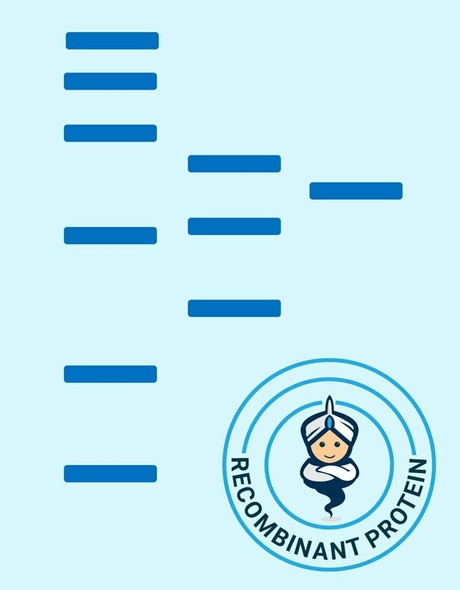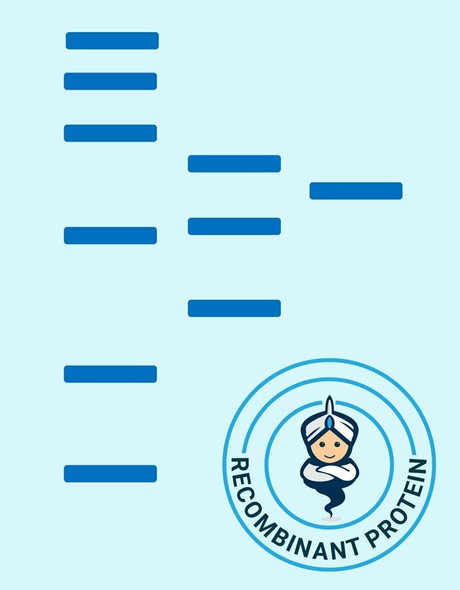Human Insulin Recombinant Protein (RPPB0691)
- SKU:
- RPPB0691
- Product type:
- Recombinant Protein
- Size:
- 250mg
- Species:
- Human
- Target:
- Insulin
- Source:
- Escherichia Coli
- Uniprot:
- P01308
Description
| Product Name: | Human Insulin Recombinant Protein |
| Product Code: | RPPB0691 |
| Size: | 250mg |
| Species: | Human |
| Target: | Insulin |
| Source: | Escherichia Coli |
| Physical Appearance: | Sterile Filtered White lyophilized (freeze-dried) powder. |
| Formulation: | The protein was lyophilized from a concentrated (1mg/ml) solution with no additives. |
| Solubility: | It is recommended to reconstitute the lyophilized Insulin in sterile 0.005N HCl not more than 1 mg/ml. |
| Stability: | Lyophilized Insulin although stable at room temperature for 3 weeks, should be stored desiccated below -18°C. Upon reconstitution Insulin should be stored at 4°C between 2-7 days and for future use below -18°C.For long term storage it is recommended to add a carrier protein (0.1% HSA or BSA).Please prevent freeze-thaw cycles. |
| Purity: | Greater than 98.0% as determined by RP-HPLC analysis. |
| Biological Activity: | The Biological Activity was determined to be 28 units/mg. |
Insulin decreases blood glucose concentration. It increases cell permeability to monosaccharides, amino acids and fatty acids. It accelerates glycolysis, the pentose phosphate cycle, and glycogen synthesis in liver.
Insulin Human Recombinant produced in E.Coli is a two chain, non-glycosylated polypeptide chain containing 51 amino acids and having a molecular mass of 5807 Dalton. Insulin is purified by proprietary chromatographic techniques.
| UniProt Protein Function: | Insulin: Insulin decreases blood glucose concentration. It increases cell permeability to monosaccharides, amino acids and fatty acids. It accelerates glycolysis, the pentose phosphate cycle, and glycogen synthesis in liver. Heterodimer of a B chain and an A chain linked by two disulfide bonds. Belongs to the insulin family. |
| UniProt Protein Details: | Protein type:Secreted; Secreted, signal peptide; Hormone Chromosomal Location of Human Ortholog: 11p15.5 Cellular Component: extracellular space; Golgi lumen; endoplasmic reticulum lumen; extracellular region Molecular Function:identical protein binding; insulin-like growth factor receptor binding; protein binding; protease binding; hormone activity; insulin receptor binding Biological Process: positive regulation of nitric oxide biosynthetic process; positive regulation of vasodilation; glucose homeostasis; activation of NF-kappaB transcription factor; positive regulation of glucose import; negative regulation of protein oligomerization; regulation of protein localization; cell-cell signaling; negative regulation of gluconeogenesis; acute-phase response; regulation of transmembrane transporter activity; negative regulation of NAD(P)H oxidase activity; positive regulation of mitosis; activation of protein kinase B; positive regulation of nitric-oxide synthase activity; negative regulation of acute inflammatory response; glucose metabolic process; positive regulation of lipid biosynthetic process; positive regulation of protein amino acid autophosphorylation; positive regulation of cell growth; positive regulation of phosphoinositide 3-kinase cascade; positive regulation of peptidyl-tyrosine phosphorylation; positive regulation of cell differentiation; negative regulation of protein catabolic process; regulation of amino acid metabolic process; negative regulation of glycogen catabolic process; wound healing; positive regulation of glycogen biosynthetic process; positive regulation of cellular protein metabolic process; glucose transport; regulation of protein secretion; negative regulation of lipid catabolic process; regulation of transcription, DNA-dependent; positive regulation of MAPKKK cascade; negative regulation of vasodilation; positive regulation of cell proliferation; negative regulation of proteolysis; negative regulation of protein secretion; MAPKKK cascade; negative regulation of fatty acid metabolic process; alpha-beta T cell activation; endocrine pancreas development; G-protein coupled receptor protein signaling pathway; positive regulation of protein kinase B signaling cascade; cellular protein metabolic process; fatty acid homeostasis; positive regulation of glycolysis; insulin receptor signaling pathway; energy reserve metabolic process; positive regulation of insulin receptor signaling pathway; regulation of insulin secretion; positive regulation of DNA replication; positive regulation of cytokine secretion; positive regulation of cell migration Disease: Diabetes Mellitus, Insulin-dependent, 2; Diabetes Mellitus, Permanent Neonatal; Hyperproinsulinemia; Maturity-onset Diabetes Of The Young, Type 10 |
| NCBI Summary: | After removal of the precursor signal peptide, proinsulin is post-translationally cleaved into three peptides: the B chain and A chain peptides, which are covalently linked via two disulfide bonds to form insulin, and C-peptide. Binding of insulin to the insulin receptor (INSR) stimulates glucose uptake. A multitude of mutant alleles with phenotypic effects have been identified. There is a read-through gene, INS-IGF2, which overlaps with this gene at the 5' region and with the IGF2 gene at the 3' region. Alternative splicing results in multiple transcript variants. [provided by RefSeq, Jun 2010] |
| UniProt Code: | P01308 |
| NCBI GenInfo Identifier: | 124617 |
| NCBI Gene ID: | 3630 |
| NCBI Accession: | P01308.1 |
| UniProt Secondary Accession: | P01308,Q5EEX2, |
| UniProt Related Accession: | P01308 |
| Molecular Weight: | 110 |
| NCBI Full Name: | Insulin |
| NCBI Synonym Full Names: | insulin |
| NCBI Official Symbol: | INS |
| NCBI Official Synonym Symbols: | IDDM; ILPR; IRDN; IDDM1; IDDM2; MODY10 |
| NCBI Protein Information: | insulin; proinsulin; preproinsulin |
| UniProt Protein Name: | Insulin |
| Protein Family: | Insulin |
| UniProt Gene Name: | INS |
| UniProt Entry Name: | INS_HUMAN |










